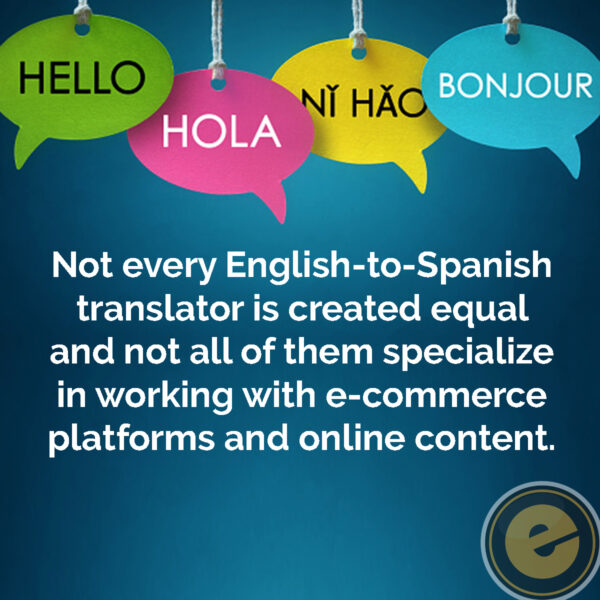
Conventional wisdom in business and media has long been to approach the United States as an English-speaking market. When other languages are included on American marketing materials, mainstream news, or product packaging, it’s often little more than an afterthought. Even this much is typically only done in particular regions or neighborhoods with large immigrant populations.
Today, however, there are over 40 million Spanish speakers living all across the United States. That’s nearly as many people as the population of Spain itself. As an English-speaking website owner, failing to consider the needs of the Spanish-speaking community or relying on Google Translate to reach this market can be costly. You’re risking your reputation and potentially alienating a large untapped customer base.
Spanish Marketing for Selling in Foreign Countries
Increasing your website’s Hispanic SEO performance can also help you reach beyond the borders of the United States. This allows you to tap into markets in Mexico and other Spanish-speaking countries. E-commerce now represents more than $15 million of annual economic activity in Mexico.
You can look to global e-commerce leaders to demonstrate the value in the Mexican market. Amazon began operations in Mexico in 2015 and had 50 million users across 25 cities in the country less than 5 years later. The Mexican e-commerce market has been ripe for expansion for some time. Mexico is also a great first target for United States businesses looking to dive into their first foreign market. This is because there are so many bilingual employees and contractors available in the United States to help with such an undertaking.
When creating website content for the Mexican market or for other Latin American countries, it’s important to do better than simply running the English version of your website through Google Translate. Google Translate is a powerful tool that can be extremely useful in helping you do business with foreign clients. However, it is not the proper resource for creating foreign language website copy.
Google Translate and other automatic translation software cannot properly translate the nuance and context of long or complex web pages. Automatically translated webpage content can lead to faux pas, senseless statements, or copy that just doesn’t flow because it sounds quite literally like a robot wrote it. While technology makes impressive strides every day, the industry standard for creating foreign language content is still to hire a capable writer or translator who works in your target language.
Hispanic SEO vs. Spanish SEO
Another problem with automatic translators is that they may default to the style of Spanish spoken in most of Spain. There are many subtle—and not so subtle—differences between this Castilian Spanish and the Latin American Spanish spoken throughout Mexico. Even within the United States, Spanish speakers utilize a multitude of different dialects. A webpage that is marketed to Mexican consumers but has been automatically translated from English to Castilian Spanish will be off-putting to your audience at best. At worst, it will be unreadable.
Working with a qualified Spanish SEO provider can deliver the human touches that make copy resonate with readers. This ensures your SEO keywords are translated effectively and utilized correctly.
Spanish SEO services for English speaking e-commerce operators are a multi-faceted endeavor that exists at the intersection of three ideas:
- Translating
- Copywriting
- SEO
Speaking a language consists of so much more than memorizing vocabulary words and understanding grammar. A high-powered SEO service that employs bilingual SEO experts will become a crucial resource for allowing you to truly communicate with your clients across the language barrier.
Identifying Your Hispanic SEO Keywords
When you begin to plan your Spanish language SEO strategy, you’ll want to begin by translating your high-performing English keywords to the correct form of Spanish. For this task, an automated translator may be acceptable for getting started. Instead of Google Translate, consider trying the Spanish-specific SpanishDict.
Its Spanish language focus will ensure solid translations and it includes additional features that will identify word variations specific to particular regions or countries. Analyze your website visitor data to see where the majority of your Spanish-speaking customers are visiting from. You can use that information to choose the correct translations of any keywords or phrases subject to different regional dialects. Identify synonyms as well, and try to work these into your keyword rotation to see what performs best.
In addition to your translated list of best English keywords to give your Spanish SEO service provider, you’ll probably want to research and identify new keywords specifically for your Spanish language content. Use Google Analytics to determine what search terms people in your target country are frequently using, just like you would when developing your English language keywords and content.
Preliminary Testing of Your Hispanic SEO Strategy
A good first project for testing the waters in your target country is to run translated ads that have performed well for you elsewhere.
Take the following steps:
- Identify your highest performing English language ads
- Choose 3 to 5 of these ads that represent a variety of tones and keywords so that you can gather data about what works best in your foreign market
- Pay a translator or Spanish SEO service provider to convert the ads to Latin American Spanish.
- Set a fixed budget and time frame for your ads to run—remember this is a preliminary data gathering campaign to help inform your strategy going forward.
- Run the ads in your target country
- Collect and analyze the data
Understanding Your Online Competition
When you start doing business in a new foreign market, it can be beneficial to study your competitors. Cultural attitudes, shopping habits, and internet browsing preferences can vary greatly from place to place. Translating great English content is not always a sure way to create great Spanish content. A thorough study of your biggest competition can help you bridge that gap.
Identify your biggest competitors, which may include whoever is selling similar products or services in the same areas you want to market to.
Spend some time visiting and researching their websites, and make a note of the following:
- Website layout
- Color schemes and visual style
- Average length of content
- Type and tone of content
- Website traffic data
- Backlinks
- Use and placement of images and multimedia
- Frequency of updates and new content
- How the content is tied to the products or services being offered
- Social media presence
Experiment by emulating elements of your competitor’s operations to see what sorts of changes help drive engagement or boost sales.
Additional Thoughts on Translation
Bilingual Spanish- and English-speaking translators are readily found at good rates in the United States. However, just as each writer has their individual strengths and areas of expertise, so do translators.
Think of all the different types of materials that sometimes require translation:
- Manuals
- Technical documents
- Legal documents
- Government reports
- News stories
- Scripts
- Subtitles and other descriptive text
- Novels, short stories, other creative writing
- And, last but not least, your website’s search engine optimized content
The point is that not every English-to-Spanish translator is created equal, and not all of them specialize in working with e-commerce platforms and online content.
Writing is sometimes compared to a sort of magic because it is a craft that allows thought to be transmitted from one person’s mind to another simply by marking symbols down on a page. Translation, then, is an even more incredible form of this magic because it allows the same to be done across language barriers and cultural differences.
The core concept of translation is simple: you take something that was written or spoken in one language and rewrite or re-speak it in another. Within that concept, however, there is room for a world of subtlety and nuance. While someone translating an important legal document will translate precisely and on a word-for-word basis, someone translating a novel or movie script will be working to recreate the correct feeling or tone more so than striving for technical accuracy.
This sort of translator becomes part of the creative process through the choices they make in interpreting one language into another. Your website’s Spanish SEO content, assuming it is written to be both practical and conversational, will fall somewhere between those two examples. Getting it right will likely require the help of a translator with a specific skill set.
Translation, Transcreation, and Localization
Transcreation and localization are two concepts that will also come into play when designing your content strategies for foreign language markets. These ideas are more of a framework than hard definitions. The concepts of translation, transcreation, and localization will mesh and overlap in the course of creating your Hispanic SEO, and the extent to which you use one or the other will depend on your strategies and target audience.
Translation
Taking something written in one language and writing it in another language. For example, the English word hello is translated to Spanish as “hola.”
Transcreation
Transcreation is similar to translation but focuses on the cultural context of both languages to overcome the emotional and tonal boundaries of a technical and precise translation. A simple example of transcreation might see the English word hello switched out for the time-specific buenos dias or buenos tardes because those are the more natural informal greetings for the target audience.
Localization
Localization can be thought of as a form of transcreation with special emphasis on a particular geographic area, be it a single neighborhood or an entire country.
Get Help With Hispanic Content
In today’s marketing landscape, using Google Translate to connect in another language is not going to cut it. In worst case scenarios, your brand looks like it’s out of touch in connecting with people. That’s bad for reputation and sales!
If organizing and executing a Hispanic content strategy seems daunting, then it’s time to get help from experienced marketing professionals.
Sources
- Soruco, G. R. (1985). MARKETING TELEVISION PROGRAMS IN THE UNITED STATES: THE CASE OF THE HISPANIC AUDIENCE (TV HABITS, ENGLISH LANGUAGE), Doctoral dissertation, Indiana University. Retrieved May 26, 2022, from https://www.proquest.com/openview/e13afbfe9035f7ce48545277dc2fa45b/1?pq-origsite=gscholar&cbl=18750&diss=y
- Statista Research Department (2021). Languages Spoken in the United States 2020. Statista. Retrieved May 26, 2022, from https://www.statista.com/statistics/183483/ranking-of-languages-spoken-at-home-in-the-us-in-2008/
- Palacios, J. J. (2001). Globalization and e-commerce: Growth and impacts in Mexico. UC Irvine Globalization of I.T. Retrieved May 26, 2022, from https://escholarship.org/content/qt2w71v0qt/qt2w71v0qt.pdf
- Durgunoqu, A. Y. (2013). Acquiring literacy in English and Spanish in the United States. Literacy development in a multilingual context: Cross-cultural perspectives, 135. Retrieved May 26, 2022, from https://escholarship.org/content/qt2w71v0qt/qt2w71v0qt.pdf
- Lipski, J. M. (2008). Varieties of Spanish in the United States. Georgetown University Press. Retrieved May 26, 2022, from https://books.google.com/books?hl=en&lr=&id=Yac_wpbaRssC&oi=fnd&pg=PR7&dq=spanish+speakers+in+the+united+states&ots=zETLN1LwDN&sig=sOx78UgR8Yt7qJrh7CWARYyBOeg#v=onepage&q=spanish%20speakers%20in%20the%20united%20states&f=false
- Pedersen, D. (2014). Exploring the concept of transcreation–transcreation as “more than translation.” Cultus: The Journal of intercultural mediation and communication, 7 , 57-71. Retrieved May 26, 2022, from https://iris.unipa.it/retrieve/handle/10447/130535/197987/cultus%20_7_2014.pdf#page=57






